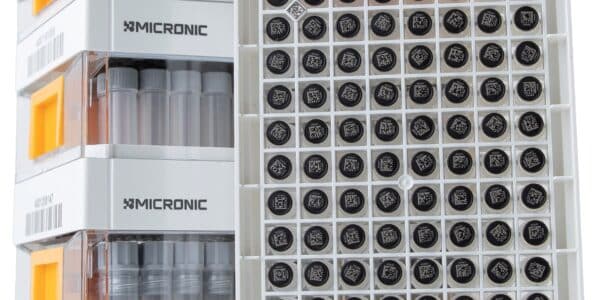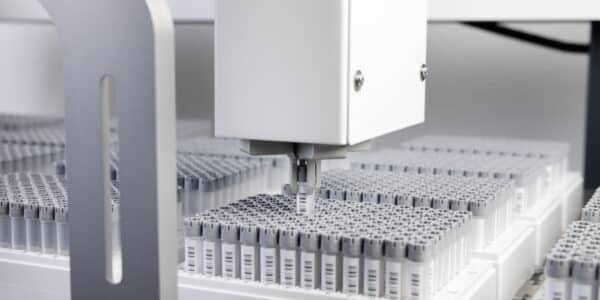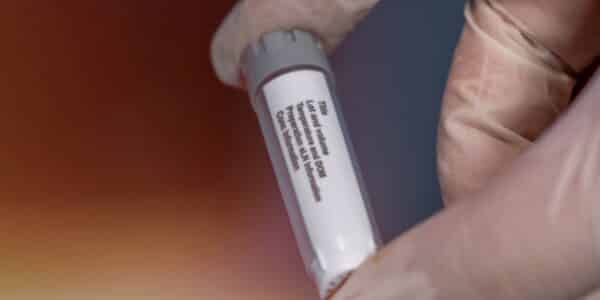
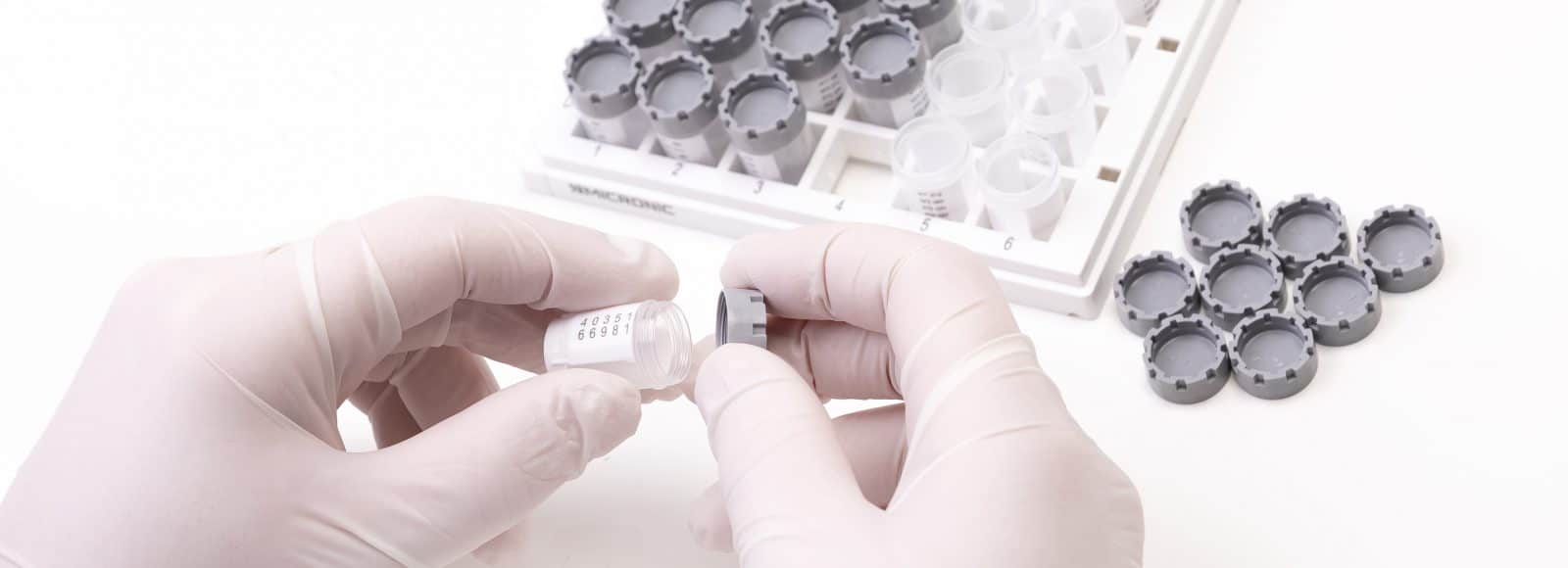
Achieve 100% sample traceability: The laser etching of tubes
The market of sample storage labware is continuously changing. A trend that we have seen evolving is the importance to ensure traceability of the sample. Where labels and printed information can’t guarantee this, the solution may lay in laser etching the information on a sample storage tube. In this blog post we will tell you more about laser etching, laser marking systems, what information you can laser etch on a sample storage tube and the uniqueness of different types of laser etched (bar)codes.
Laser etching
Laser etching is a technique where the information is directly laser marked on the labware, eliminating the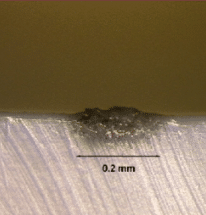 need for printed labels, which can fall off during freeze thaw cycles and printed ink that can wear, so the information is permanent and reliable. This is possible due to the fact that the pigment penetrates below the (tube) surface and can never wear or fall off (see picture on the right). Thereby sample traceability can be guaranteed.
need for printed labels, which can fall off during freeze thaw cycles and printed ink that can wear, so the information is permanent and reliable. This is possible due to the fact that the pigment penetrates below the (tube) surface and can never wear or fall off (see picture on the right). Thereby sample traceability can be guaranteed.
In addition to the fact that a manufacturer, like Micronic, laser etches standard (bar)codes on tubes, there are also instruments on the market like the AFYS3G Laser Markers that allow you to laser etch any sample information yourself. Benefits that come with laser etching sample information rather than labelling a tube or printing the information on a tube, is the fact that the manual labor of labelling or printing is removed. A laser marking system only demands a list of information to be lasered on the tubes. Furthermore, no extra costs are incurred when information is laser etched on a tube. You can think of costs for consumables like labels or ink cartridges. But what are the possibilities of a laser marking system in terms of information that can be laser etched?
What information can be laser etched?
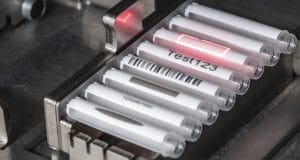
There are a range of options that can be laser etched on a tube. With the laser marking systems that are currently available on the market it is possible to laser etch alphanumeric codes, 1D barcodes and 2D Data-Matrix codes on a tube. But not only codes for sample traceability can be laser etched, other options are text and logos. In the pictures on the right you can find some examples. It is possible 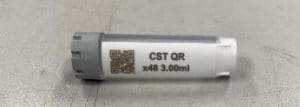 to put almost any information you want on your sample storage tube. Furthermore, for the smallest of tubes, it is hard to attach a very small label to your tube. With laser marking, a fine print can be used so that even the smallest of sample tubes can be laser etched. To assure traceability of the sample, uinqueness of a code is of utmost importance. So how unique are the different codes that can be laser etched on a sample storage tube?
to put almost any information you want on your sample storage tube. Furthermore, for the smallest of tubes, it is hard to attach a very small label to your tube. With laser marking, a fine print can be used so that even the smallest of sample tubes can be laser etched. To assure traceability of the sample, uinqueness of a code is of utmost importance. So how unique are the different codes that can be laser etched on a sample storage tube?
Uniqueness of different laser etched codes
As mentioned above, the following codes can be laser etched on a tube: an alphanumeric code, a 1D barcode or a 2D Data-Matrix code. What is the difference between these codes and how unique are they?
Alphanumeric Code
The alphanumeric code is the least unique code. It correspondents with the place in the rack the tube is positioned in, therefore this code is unique per rack. Within the rack you will have unique codes, but outside of the rack there is no difference between the racks. The alpanumeric code works well when you need to trace a sample in a rack quickly and uniqueness per rack only is required. However, with a large sample database, a 1D barcode or a 2D Data-Matrix code would be more useful.
1D Barcode
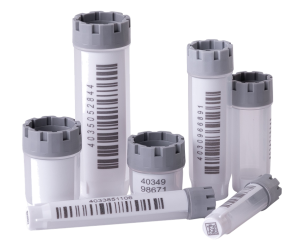
More unique are the 1D barcodes which offer more options for you when you need to differentiate between the samples. In addition to the barcode, 1D barcodes also have a numeric code that be read with the human eye and differs itself in the widths and spaces between the vertical bars. There are a many different types of 1D barcodes. Micronic for example uses the industry standard 128B 1D barcode, which is a barcode consisting of 10 different numbers and has the possibility to add 3 symbols as well. The code can consist of 3 symbols or letters and 10 numbers which corresponds with the 2D Data-Matrix code on the bottom of the tube. This means that the number of possiblities are similar for the 1D barcode and 2D Data-Matrix code. It is beneficial to have a 1D barcode on the side of the tube, because it serves as an extra verification and the (alpha)numeric code can be read by the human eye.
2D Data-Matrix Code
With almost infinite possibilities, the 2D Data-Matrix code is ideal when you have to store many samples and don’t want to worry about using multipe coding systems. The 2D Data-Matrix is an open 2D code comprising of a 10-digit number which can be custom coded. Next to the 10-digit number, 3 symbols can be added into the code as well. For this a 2D Data Matrix code of 14×14 is used to have enough space for 3 symbols or letters and 10 numbers. With a 2D Data-Matrix code there are around 10 billion different possibilities, guaranteeing (manufacturer) unique codes for all your samples. In addition to the 2D Data-Matrix code that Micronic standard laser etches on the bottom of the tube, a 2D Data-Matrix code on the side of the tube can also be requested. Micronic’s 2D Data-Matrix code system is ISO/IEC TR 29158 (AIM DPM-1-2006) certified.
Infinite possibilities
There are infinite possibilities when laser etching sample information on a storage tube. With numerous possibilities as to what can be laser etched on a sample storage tube and the fact that the information can never wear or fall off, is laser etching the ultimate way to achieve 100% sample traceability so that you do not have to worry anymore about losing your valuable samples.
